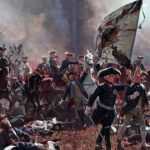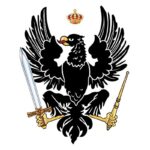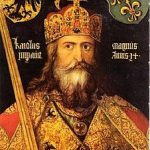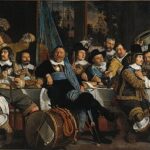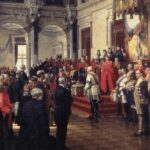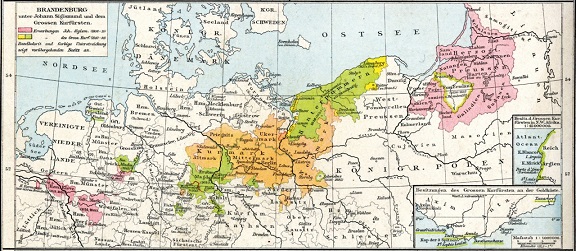
In the aftermath of the Thirty Years’ War, most of Germany lay in ruins – disunited, depopulated, and politically fragmented. Yet out of this chaos rose a seemingly unlikely power: Brandenburg-Prussia. Small, scattered, and lacking natural resources, the state would transform over the next century into a disciplined, centralized, and respected European force.
The rise of Brandenburg-Prussia is one of German history’s most remarkable success stories. It’s a tale of strategic marriages, bold leadership, relentless military reform, and shrewd diplomacy. Let’s explore how this improbable state carved out its place at the heart of Central Europe – and set the stage for modern Germany.
The Foundations: Geography and Dynasty
Brandenburg-Prussia was not a single territory but a personal union of scattered lands:
- Brandenburg, centered on Berlin, was part of the Holy Roman Empire.
- Ducal Prussia, east of the Vistula River, was outside the empire and a former territory of the Teutonic Knights.
- Additional holdings included Cleves, Minden, and parts of Pomerania.
These lands had little in common – different religions, laws, and cultures – but were united under the ambitious House of Hohenzollern.
Frederick William, the “Great Elector” (1640–1688)
The true architect of Brandenburg-Prussia’s rise was Frederick William, who inherited the title Elector of Brandenburg in 1640, just as the Thirty Years’ War was still raging.
Key Achievements:
- Restored order after wartime devastation.
- Built a standing army – rare for a German state at the time.
- Reformed taxation to fund the military without dependence on estates.
- Centralized administration and reduced noble power.
He negotiated wisely at the Peace of Westphalia, gaining parts of Western Pomerania and securing greater sovereignty. Later, he acquired East Pomerania and began expanding into the Baltic.
Frederick William also welcomed Huguenot refugees from France, boosting trade and skilled labor.
Frederick I and the Birth of the Prussian Kingdom
In 1701, Frederick William’s son, Frederick III, crowned himself King in Prussia (not “of Prussia” to avoid conflict with the Holy Roman Emperor). He became Frederick I.
While more focused on courtly grandeur than reform, he secured:
- Imperial recognition of Prussian kingship.
- Diplomatic prestige through alliances.
- Foundations for a recognized, sovereign monarchy.
This step elevated Brandenburg-Prussia from a collection of territories to a European kingdom.
Frederick William I, the “Soldier King” (1713–1740)
Frederick I’s son, Frederick William I, transformed the kingdom with a singular focus: the military.
Achievements:
- Tripled the size of the army to over 80,000 troops.
- Created a disciplined, professional officer corps.
- Introduced military education and logistics reforms.
- Instituted frugal budgeting and eliminated waste.
He is often remembered for the Potsdam Giants, a regiment of tall soldiers, but his deeper legacy was building the army into the backbone of the state. “Prussia is not a state with an army,” he reportedly said. “It is an army with a state.”
Under his rule, Prussia became a feared military presence – despite its relatively small population and landmass.
Social, Economic, and Administrative Reforms
The rise of Brandenburg-Prussia wasn’t just about military might:
- The bureaucracy became more centralized, merit-based, and efficient.
- Nobles (Junkers) retained local control but were tied closely to military service.
- Towns expanded commerce, attracted artisans, and opened schools.
Frederick William I implemented economic policies that prioritized agrarian reform and fiscal discipline. Manufacturing, especially arms production, received state support, laying foundations for industrial expansion in later generations.
Religious tolerance – particularly under Frederick William – enabled the absorption of refugees and skilled workers, helping rebuild towns and bolster economic resilience.
Brandenburg-Prussia on the European Stage
By the 1720s, Brandenburg-Prussia was a respected player in European diplomacy:
- It played a balancing role between Austria, France, and Russia.
- Alliances were made through strategic marriages and military treaties.
- The army was offered as a bargaining chip in imperial affairs.
As a member of the Holy Roman Empire, Brandenburg maintained imperial influence, but its rulers also looked eastward to expand influence in Polish and Baltic territories.
Cultural Development and Identity
Though often viewed through a military lens, Brandenburg-Prussia also nurtured cultural growth:
- Universities in Halle and Königsberg advanced theology, philosophy, and medicine.
- Frederick I sponsored art and architecture, modeling his court on Versailles.
- A distinct Prussian identity – rooted in discipline, service, and loyalty – began to form.
This fusion of intellectual rigor and military pride shaped the character of the state and its elite for decades to come.
The rise of Brandenburg-Prussia wasn’t inevitable – but it was intentional. Through vision, discipline, and relentless reform, the Hohenzollerns transformed a fragmented realm into a powerful, modernizing state. By building a formidable army, strengthening administration, and projecting diplomatic influence, they laid the groundwork for Prussia’s emergence as a major player in European politics.
Related Topics:
Reformation and Early Modern Period – Explore the major transformations in German history from the 16th to early 19th centuries, including religious upheaval, political change, and cultural milestones.
Martin Luther and the 95 Theses – Discover how Luther’s 1517 protest against indulgences sparked the Protestant Reformation and forever altered the religious landscape of Germany and Europe.
The German Peasants’ War (1524–1525) – A major uprising of peasants and lower classes inspired by Reformation ideals, this war revealed deep social tensions in early modern Germany.
The Thirty Years’ War and Its Impact on Germany – This devastating conflict reshaped Central Europe, leading to massive depopulation, destruction, and long-term political fragmentation in the German lands.
The Peace of Westphalia (1648) – The treaty that ended the Thirty Years’ War established new political boundaries and is considered a foundation of modern international diplomacy.
The Peace of Augsburg – Discover the Peace of Augsburg, its role in shaping Germany’s religious landscape, and how it laid the groundwork for centuries of conflict and compromise.
The Enlightenment in the German States – Learn how German philosophers, writers, and reformers contributed to the broader European Enlightenment with ideas on reason, science, and governance.
German Scientific and Cultural Achievements (18th Century) – Explore the flourishing of music, philosophy, and science in 18th-century Germany, from Bach and Goethe to Kant and Humboldt.
Frederick the Great of Prussia – Examine the reign of Frederick II, a military strategist and Enlightened monarch who modernized Prussia and expanded its influence.
The Napoleonic Wars and the Confederation of the Rhine – Discover how Napoleon’s reshaping of German territories led to the end of the Holy Roman Empire and the formation of a French-aligned confederation.
The Congress of Vienna and the German Confederation – Understand how European powers redrew the map after Napoleon’s defeat, establishing the German Confederation as a loose alliance of states.
